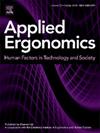Establishing moment-angle equations to predict low back exoskeleton support moment
IF 3.4
2区 工程技术
Q2 ENGINEERING, INDUSTRIAL
引用次数: 0
Abstract
Exoskeletons have emerged as a promising technology for potentially mitigating the risk of injuries by providing mechanical support and reducing loads on the body. There are a variety of low back passive exoskeletons currently available. While manufactures do provide specifications on the peak supportive moment capabilities, little is known about their moment-angle relationship through their full range of motion. This information is valuable when deciding on which exoskeleton best supports the task demands on job. This study aimed to develop moment-angle equations for two passive low back support exoskeletons (SuitX BackX and Laevo V2.5). These equations can provide valuable insights into the mechanical behavior and the extent of supportive moment delivered by passive low-back support exoskeletons during dynamic tasks. These equations can be used from a preventative perspective to help practitioners understand how much support may be provided given task and operator characteristics. For experimental data collection, we secured exoskeletons on a dynamometer (Biodex System 4) and loaded in a full range of motion with five different loading rates, i.e., 5, 10, 20, 30, 45, and 60 deg/sec. Results show polynomial regression equations for each exoskeleton, motion, support setting and angular velocity which were determined based on low mean square error and high-squared values. Implications for this work include integration within digital human modeling technology to help determine the need for exoskeleton implementation as a tool that can reduce the risk of work-related musculoskeletal injury.
建立矩角方程,预测下背部外骨骼支撑力矩
外骨骼已经成为一项很有前途的技术,它通过提供机械支持和减轻身体负荷来潜在地降低受伤的风险。目前有各种各样的下背部被动外骨骼可用。虽然制造商确实提供了峰值支撑力矩能力的规格,但人们对其在全运动范围内的力矩-角度关系知之甚少。当决定哪个外骨骼最能支持工作中的任务需求时,这些信息是有价值的。本研究旨在建立两种被动式下背部支撑外骨骼(SuitX BackX和Laevo V2.5)的矩角方程。这些方程可以为动态任务中被动下背支撑外骨骼提供的机械行为和支持力矩的程度提供有价值的见解。这些方程可以从预防的角度使用,以帮助从业者了解给定任务和操作员特征可以提供多少支持。为了收集实验数据,我们将外骨骼固定在一个测力计(Biodex System 4)上,并以五种不同的加载速率加载全范围的运动,即5、10、20、30、45和60度/秒。结果表明,基于低均方误差和高平方值确定了各外骨骼、运动、支撑设置和角速度的多项式回归方程。这项工作的意义包括整合数字人体建模技术,以帮助确定外骨骼作为一种工具的需求,这种工具可以降低与工作有关的肌肉骨骼损伤的风险。
本文章由计算机程序翻译,如有差异,请以英文原文为准。
求助全文
约1分钟内获得全文
求助全文
来源期刊

Applied Ergonomics
工程技术-工程:工业
CiteScore
7.50
自引率
9.40%
发文量
248
审稿时长
53 days
期刊介绍:
Applied Ergonomics is aimed at ergonomists and all those interested in applying ergonomics/human factors in the design, planning and management of technical and social systems at work or leisure. Readership is truly international with subscribers in over 50 countries. Professionals for whom Applied Ergonomics is of interest include: ergonomists, designers, industrial engineers, health and safety specialists, systems engineers, design engineers, organizational psychologists, occupational health specialists and human-computer interaction specialists.
 求助内容:
求助内容: 应助结果提醒方式:
应助结果提醒方式:


